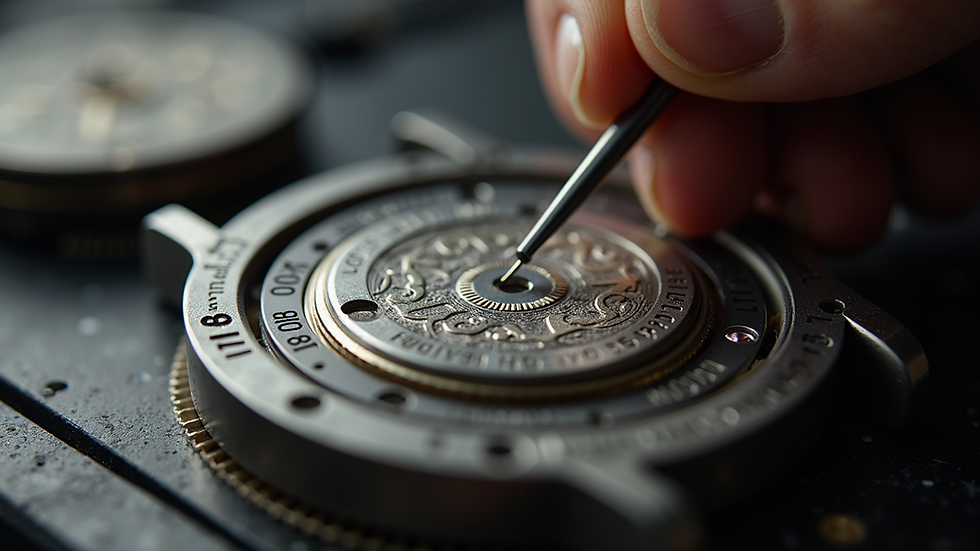The Art and Craftsmanship Behind Building Watches
- Admin
- Sep 22
- 4 min read
Watches are more than just tools to tell time. They are masterpieces of engineering, design, and tradition. The art and craftsmanship behind building watches combine precision, creativity, and patience. Each watch tells a story of skillful hands and innovative minds working together to create something timeless. This article explores the fascinating world of watch craftsmanship, revealing the secrets behind these intricate devices.
Understanding Watch Craftsmanship
Watch craftsmanship is a blend of art and science. It involves designing, assembling, and finishing a watch with meticulous attention to detail. Skilled artisans and engineers collaborate to ensure every component fits perfectly and functions flawlessly.
The process begins with the design phase, where aesthetics meet functionality. Designers sketch the watch’s appearance, considering factors like dial layout, case shape, and strap material. This stage sets the tone for the entire project.
Next comes the selection of materials. High-quality metals, sapphire crystals, and durable leather or metal bands are chosen to ensure longevity and style. The choice of materials affects not only the watch’s look but also its durability and comfort.
Craftsmanship also includes hand-finishing techniques such as polishing, engraving, and decorating the movement. These details elevate a watch from a simple timepiece to a work of art. For example, Geneva stripes or perlage patterns on the movement parts showcase the artisan’s skill.

The Importance of Precision in Watch Craftsmanship
Precision is the cornerstone of watch craftsmanship. Every tiny gear, spring, and screw must be perfectly made and assembled to ensure accurate timekeeping. Even the smallest error can affect the watch’s performance.
Watchmakers use specialized tools and machines to create components with micrometer accuracy. The balance wheel, escapement, and mainspring are critical parts that regulate the watch’s movement. Their precise interaction determines the watch’s reliability.
To maintain precision, watchmakers often assemble movements by hand. This allows them to adjust and fine-tune each part carefully. The process requires steady hands, sharp eyes, and years of experience.
Quality control is another vital aspect. Watches undergo rigorous testing for accuracy, water resistance, and durability. This ensures that the final product meets high standards and satisfies customers.
How is a watch manufactured?
The manufacturing of a watch is a complex process that combines traditional techniques with modern technology. It typically involves several stages:
Component Production: Individual parts such as gears, screws, and plates are produced using CNC machines or hand-crafted methods. Materials like stainless steel, brass, and synthetic rubies are common.
Movement Assembly: The heart of the watch, the movement, is assembled by skilled watchmakers. This includes installing the mainspring, gear train, escapement, and balance wheel.
Dial and Hands Installation: The dial is carefully placed on the movement, followed by the attachment of the hour, minute, and second hands.
Casing: The assembled movement and dial are encased in the watch case. This step also involves fitting the crystal and sealing the case to protect against dust and moisture.
Strap or Bracelet Attachment: The final touch is adding the strap or bracelet, which complements the watch’s design and ensures comfort.
Testing and Quality Control: Each watch undergoes thorough testing for time accuracy, water resistance, and overall functionality.
This detailed process highlights the dedication and expertise required in watch manufacturing. It is a perfect blend of craftsmanship and technology.

Materials and Techniques in Watchmaking
The choice of materials and techniques significantly impacts the quality and appearance of a watch. Here are some common materials used in watchmaking:
Stainless Steel: Durable and resistant to corrosion, ideal for cases and bracelets.
Gold and Platinum: Precious metals used for luxury watches, offering elegance and value.
Sapphire Crystal: Scratch-resistant glass protecting the dial.
Leather and Rubber: Popular materials for straps, providing comfort and style.
Techniques such as hand engraving, guilloché (a decorative pattern), and enameling add artistic value. These methods require specialized skills and patience.
For example, hand engraving involves carving intricate designs on the watch case or movement parts. This technique makes each watch unique and highly collectible.
Another technique, guilloché, uses a rose engine lathe to create repetitive patterns on the dial or movement. This adds depth and texture, enhancing the watch’s visual appeal.

Caring for Your Watch: Tips from the Experts
Proper care extends the life and beauty of a watch. Here are some practical tips to maintain your timepiece:
Regular Cleaning: Wipe the watch with a soft cloth to remove dirt and sweat. For metal bracelets, use a soft brush and mild soap.
Avoid Water Damage: Even water-resistant watches have limits. Avoid exposing your watch to water unless it is specifically designed for swimming or diving.
Service Regularly: Have your watch serviced by a professional every 3-5 years. This includes cleaning, lubrication, and adjustment.
Store Properly: Keep your watch in a cool, dry place. Use a watch box or pouch to protect it from dust and scratches.
Avoid Magnetic Fields: Strong magnets can affect the accuracy of mechanical watches. Keep your watch away from electronic devices and magnetic closures.
By following these recommendations, you can enjoy your watch’s craftsmanship and functionality for many years.
The art and craftsmanship behind building watches reflect a rich heritage of skill, innovation, and passion. From the precise assembly of tiny components to the artistic finishing touches, every step is a testament to human creativity and dedication. Whether you are a collector or simply appreciate fine objects, understanding this process deepens your appreciation for these timeless instruments.



Comments